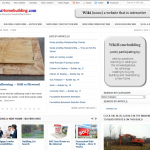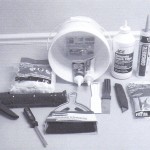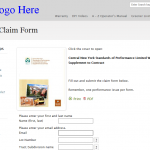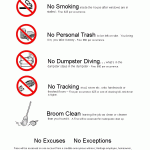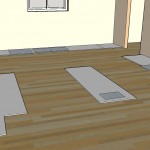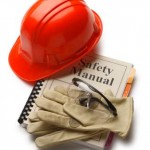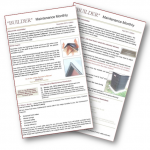Skip to: Water Problems
Performance Standard: HBR articles 12-1 to 12-14 Click icon to view book 
Power-Vent water heater not working due to VOC’s (volatile organic compounds) in the air
PERFORMANCE GUIDELINE: Power vented water heaters manufactured after June 2006 are mandated by the government to be protected by a VOC sensor. When exposed to VOC, e.g. gasoline, oil paint, brush cleaning materials, vanishes, oil stains, to name a few, the tank will automatically shut down. The tank then must be serviced by a technician. The builder is not responsible for the service call or parts to fix this problem.
Warranty Period: NONE
Discussion:
The homeowner should be aware that working in the basement with different chemicals could cause this problem to occur. Refer to your hot water tank manual for trouble shooting.
Water system pipe leak
Warranty period: 2 years
Condensation appears on pipes, toilets, and plumbing supply lines.
Warranty period: NONE
Dripping faucet
CORRECTIVE MEASURE: None. Builder will repair or replace dripping faucets, one time only, if dripping faucet has been noted by the homeowner and builder on the Final Walk Through form prior to closing.
Warranty period: NONE
Frozen Pipes
CORRECTIVE MEASURE: The builder will correct any situations not meeting code for the “as built” structure. The builder is not responsible for any damage resulting from a power failure or any loss of power supply or the lack of regular maintenance or any alteration of the system as installed.
Warranty Period: 2 years
Defective Items (plumbing fixtures, appliance, or trim fittings etc.)
CORRECTIVE MEASURE: None. Unless noted on Final Walk Through form.
Warranty period: NONE
Porcelain or fiberglass plumbing fixture is cracked or chipped,
CORRECTIVE MEASURE: Builder will repair chips and/or cracks visible from a distance of 3 feet or replace fixtures, one time only if noted on Final Walk Through form.
Warranty period: NONE
Toilet not removing waste
CORRECTIVE MEASURE: More than one flush may be required.
Warranty period: NONE
Clogging of sewer and/or waste lines.
Warranty period: NONE
Sump pump malfunction
PERFORMANCE GUIDELINE: Covered under manufacturer’s warranty. More information
Warranty period: NONE
Note
See picture tips here (modify link page as needed to match specs)
Homeowner Operation and Maintenance
Aerators – Even though your plumbing lines have been flushed to remove dirt and foreign matter, small amounts of minerals may enter the line. Aerators on the faucets strain much of this from your water. Minerals caught in these aerators may cause the faucets to drip because washers wear more rapidly when they come in contact with foreign matter.
Cleaning – Follow manufacturer’s directions for cleaning fixtures. Avoid abrasive cleansers. They remove the shiny finish and leave behind a porous surface that is difficult to keep clean. Clean plumbing fixtures with a soft sponge and soapy water (a nonabrasive cleaner or a liquid detergent is usually recommended by manufacturers). Then polish the fixtures with a dry cloth to prevent water spots. Care for brass fixtures with a good-quality brass cleaner, available at most hardware stores.
Clogs – While low flush toilets are better for the environment, they may clog more easily. The main causes of toilet clogs are domestic items such as disposable diapers, excessive amounts of toilet paper, sanitary supplies, Q-tips, dental floss, and children’s toys.
Improper garbage disposal use also causes many plumbing clogs. Always use plenty of cold water when running the disposal. This recommendation also applies to grease; supplied with a steady flow of cold water, the grease congeals and is cut up by the blades. If you use hot water, the grease remains a liquid, then cools and solidifies in the sewer line. Allow the water to run 10 to 15 seconds after shutting off the disposal.
You can usually clear clogged traps with a plumber’s helper (plunger). If you use chemical agents, follow directions carefully to avoid personal injury or damage to the fixtures.
Clean a plunger drain stopper—usually found in bathroom sinks—by loosening the nut under the sink at the back, pulling out the rod attached to the plunger, and lifting the stopper. Clean and return the mechanism to its original position. Tub drain clogs
Dripping Faucet – You can repair a dripping (Moen) faucet by shutting off the water at the valve directly under the sink, then removing the faucet stem, changing the washer, and reinstalling the faucet stem. The shower head is repaired the same way. Replace the washer with another of the same type and size. You can minimize the frequency of this repair by remembering not to turn faucets off with excessive force. Moen repair site (Please note that some manufacturers do not use rubber washers.)
Extended Absence – If you plan to be away for an extended period, you should drain your water supply lines. To do this, shut off the main supply line and open the faucets to relieve pressure in the lines. You may also wish to shut off the water heater. Do this by turning off the cold water supply valve on top and the gas control at the bottom. Drain the tank by running a hose from the spigot on the bottom to the basement floor drain or sump well. If you leave the tank full, keep the pilot on and set the temperature to its lowest or “vacation” setting. Check manufacturer’s directions for additional hints and instructions.
Freezing Pipes – Provided the home is heated at a normal level, pipes should not freeze at temperatures above 0 degrees Fahrenheit. Set the heat at a minimum of 55 degrees F if you are away during winter months. Keep garage doors closed to protect plumbing lines running through this area from freezing temperatures.
In unusually frigid weather or if you will be gone more than a day or two, open cabinet doors to allow warm air to circulate around pipes. Use an ordinary hair dryer to thaw pipes that are frozen. Never use an open flame.
Finish on Fixtures or Faucets – Avoid using any abrasive cleaners fixtures and faucets. Use only mild detergent and water or a cleaning product recommended by the manufacturer.
Laundry Tub – If you have a laundry room tub, the faucet does not have an aerator. This is to allow the laundry tub faucet to accept a hose connection.
Leaks – If a major plumbing leak occurs, the first step is to turn off the supply of water to the area involved. Sinks and toilets have individual supply shut-offs, tubs and showers usually do not. This means shutting off the water to the entire home may be necessary. The main water shut off is usually located in the basement in line with the water meter. Contact the appropriate contractor.
Low Flush Toilets – We want to draw your attention to a water-saving regulation that went into effect in 1993, which prohibits the manufacture of toilets that use more than 1.6 gallons of water per flush. In the search for a balance among comfort, convenience, and sensible use of natural resources, the government conducted several studies. The 1.6-gallon toilet turned out to be the size that overall consistently saves water.
As a result of implementing this standard, flushing twice is occasionally necessary to completely empty the toilet bowl. Even though you flush twice on occasion, rest assured that overall you are saving water and we have complied with the law. Similarly, flow restrictors are manufactured into most faucets and all shower heads and cannot be removed. We apologize for any inconvenience this may cause.
Low Pressure – Occasional cleaning of the aerators on your faucets (normally every three to four months) will allow proper flow of water. The water department controls the overall water pressure.
Outside Faucets – Outside faucets (spigots or hose bibs) are anti-frost, but in order for this feature to be effective, you must remove hoses during cold weather, even if the faucet is located in your garage. If a hose is left attached, the water that remains in the hose can freeze and expand back into the faucet, causing a break in the line. Repair of a broken line that feeds an exterior faucet is a maintenance item. Note that Heritage Homes does not warrant outside faucets against freezing.
Porcelain – You can damage porcelain enamel with a sharp blow from a heavy object or by scratching. Do not stand in the bathtub wearing shoes unless you have placed a protective layer of newspaper over the bottom of the tub. If you splatter paint onto the porcelain enamel surfaces during redecorating, wipe it up immediately. If a spot dries before you notice it, use a recommended solvent.
Running Toilet – To stop running water, check the cut-off float in the tank. You will most likely find it has lifted too high in the tank, preventing the valve from shutting off completely. In this case, gently bend the float rod down until it stops the water at the correct level. The float should be free and not rub the side of the tank or any other parts. Also check the chain on the flush handle. If it is too tight, it will prevent the rubber stopper at the bottom of the tank from sealing, resulting in running water.
Shut-Offs – Your main water shut-off is located near your water meter. You use this shut-off for major water emergencies such as a water line break or when you install a sprinkler system or build an addition to your home.
Each toilet has a shut-off on the water line under the tank. Hot and cold shut-offs for each sink are on the water lines under the sink.
Stainless Steel – Clean stainless steel sinks with a mild abrasive like Comet and water to preserve their luster. Avoid using steel wool pads; these will damage the finish. Prevent bleach from coming into prolonged contact with the sink as it can pit the surface. An occasional cleaning with a good stainless steel cleaner will enhance the finish. Rub in the direction of the polish or grain lines and dry the sink to prevent water spots.
Avoid leaving produce on a stainless steel surface, since prolonged contact with produce can stain the finish. Also avoid using the sink as a cutting board; sharp knives will gouge the finish.
Sump Pump – Onondaga County Sanitation Code requires that the footing drains, if any, be connected to a sump pump. In the case of sump pump installation, sump water will be ejected by an approved method to on-site grades and swales. If the sump pump will not start, shake the pipe to rid the system of foreign debris before contacting the Heritage Homes office or the plumber. Heritage Homes shall not be liable for any damage to persons or property resulting from any flooding or water accumulation in the basement as a result of a malfunction in the sump pump, whether by a power outage or any other cause.
Whirlpool Tubs – If your home includes a jetted tub follow manufacturer directions for its use and care. Never operate the jets unless the water level is at least one inch above the jets. Tie or pin long hair to keep it from away from the jets where it might become tangled—a potentially dangerous event. Always supervise children in a tub; never leave them unattended.
Clean and disinfect the system every one to two months, depending on usage. To do this, fill the tub with lukewarm water and add one cup of liquid chlorine bleach. Run the jets for 10 to 15 minutes, drain and fill again. Run for 10 minutes with plain water, drain.
Auto wax will help seal and preserve your tub’s surface. Avoid abrasive cleansers.
Before calling for service, check to confirm that the:
(No WaterAnywhere in the Home)
- Main shut off at the meter inside your home is open.
- Main shut off at the street is open.
- Individual shut-offs for each water-using item is open.
(No Hot Water)
- See Water Heater
(Leak Involving One Sink, Tub, or Toilet)
- Check caulking and grout.
- Confirm shower door or tub enclosure was properly closed.
- Turn water supply off to that item.
Use other facilities in your home and report problem on next business day.
(Leak Involving a Main Line)
- Turn water off at the main shut off at the meter in your home.
- Call emergency number for service.
Back-Up at One Toilet
If only one toilet is affected, corrections occur during normal business hours
- Shut off the water supply to the toilet involved.
- Use a plunger to clear the blockage.
- Use a snake to clear the blockage.
If you’ve been in your home fewer than 30 days, contact BUILDER or the plumber listed on your Emergency Phone Numbers sheet.
Sewer Back Up Affecting Entire Home
- Contact Heritage Homes or the plumber listed on your Contractor Phone Numbers sheet during the warranty period .
- Remove personal belongings to a safe location. If items are soiled, contact your homeowner insurance company.
Even if the troubleshooting tips do not identify a solution, the information you gather will be useful to the service provider you call.
A plumbing emergency is:
- Total loss of water
- Plumbing leak that requires the entire water supply to be shut off
- Call Plumber XXX-XXXX
Greener Living Tips
Toilet bowl cleaner – Sprinkle baking soda inside the bowl as you would any scouring powder. Add a couple drops of soap in also. Scrub with a toilet bowl brush and finish outside surfaces with a damp cloth or paper towel sprinkled with baking soda.
Drain cleaner – This recipe will free minor clogs and helps to prevent future clogs. Pour 1/2 cup of baking soda down the drain first, then 1/2 cup vinegar. Let it fizz for a few minutes. Then pour down a teakettle full of boiling water. Repeat if needed. If the clog is stubborn, use a plunger. If very stubborn, use a mechanical snake.
BUILDER Limited Warranty Guidelines
During the final walk through we will confirm that all plumbing fixtures are in acceptable condition and are functioning properly, and that all faucets and drains operate freely.
The performance standards will be met.
Cosmetic Damage – BUILDER will correct any fixture damage noted on the final walk through list. Repairing chips, scratches, or other surface damage noted subsequent to the final walk through list is your responsibility.
Exterior Faucets – BUILDER will repair leaks at exterior faucets noted on the final walk through list. Subsequent to final walk through, repair of a broken line to an exterior faucet is your responsibility.
Freezing Pipes – BUILDER will correct conditions that lead to frozen pipes if those conditions were not caused by the homeowner. Set heat at 55 degrees F if you are away during winter months. Keep garage doors closed to protect plumbing lines that run through this area.
Leaks – BUILDER will repair leaks in the plumbing system. We do not make adjustments for consequential damages (for example, damage to wallpaper, drapes, and personal belongings). Insurance should cover these items.
Noise – Changes in temperature or the flow of the water itself will cause some noise in the pipes. This is normal and requires no repair. BUILDER will inspect and attempt to alleviate persistent water hammer conditions.
Supply – BUILDER will correct construction conditions that disrupt the supply of water to your home if they involve service from the main water supply to your home, provided actions of yours have not caused the problem. Disruption of service due to failure of the water department system is the responsibility of the water department to correct.
